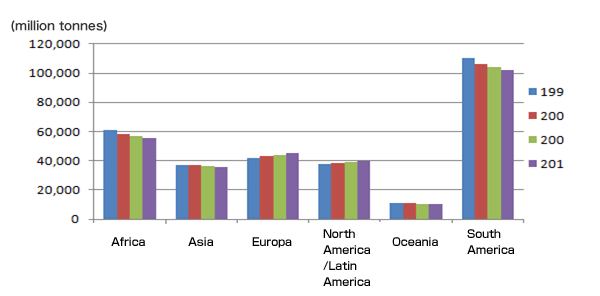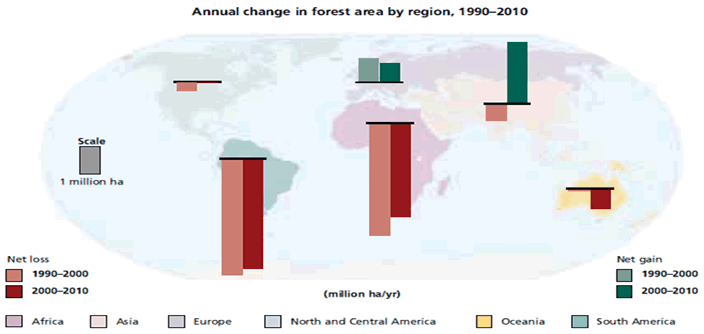Current Discussion in UNFCCC and other international framework
REDD/REDD+
Definition of REDD/REDD+
Definition of REDD
REDD stands for “Reducing Emissions from Deforestation and forest degradation in Developing countries.”
Definition of REDD+
"REDD+" goes beyond deforestation and forest degradation, and includes the role of conservation, sustainable management of forests and enhancement of forest carbon stocks.
Background
The Food and Agriculture Organization (FAO) has been collecting approved national report data, and has published measured changes in global forest area and its average annual change rate from 1990 to 2010. According to their report, during the decade from 1990 to 2000, there was a reduction in forest area amounting to 8.3 million hectares (ha) every year worldwide, and forest area continued to decrease by an average of 5.21 million ha every year from 2000 to 2010.
As a result, the FAO report indicates that the total amount of global forest biomass carbon stocks, excluding Europe and North/Central America, continued to decline by 500 million tonnes every year from 2005 to 2010.
Annual change in forest biomass carbon stocks, 1990-2010

Source:
FAO(2010) Global Forest Resources Assessment 2010 Main report,p.18
The South American region showed the biggest decline in forest area, amounting to an average of 4 million ha every year during the period from 1990 to 2010, followed by the African region, which showed an annual decline in forest area of 3.6 million ha. In Oceania, the rate of decline in forest area has accelerated since 2000: its forest area declined by 700,000 ha every year during the period from 2000 to 2010. This was mainly caused by flooding and bushfires in Australia.
Annual change in forest area by region (1990-2010)

Source:
FAO (2010) Global Forest Resources Assessment 2010 Main Report, p.18.
According to the Fourth Assessment Report of the Intergovernmental Panel on Climate Change (IPCC), published in 2007, CO2 emissions caused by changes in land use, including logging by the forest industry, is equivalent to 17% of total global emissions. This is the second-largest source of emissions after emissions from fossil fuels. This is why REDD and REDD+ are now drawing a great deal of attention to important measures to prevent deforestation and degradation of forest lands, especially from the standpoint of measures to prevent climate change.
A Brief History of REDD/REDD+
Article 3 of the Kyoto Protocol stipulates that increases in carbon stocks through afforestation and similar activities from 1990 onward should be converted to and calculated as greenhouse gas emissions reductions, but that reduction in forest areas counted as carbon stocks after 1990 caused by the conversion of forest to urban land or agricultural land use should be calculated as emissions increases. These are defined as land use, land-use change, and forestry (LULUCF). The specific rules for making use of LULUCF activities were discussed at the COP7 meeting in 2001, where four additional activities (forest land management, grazing land management, re-vegetation, and cropland management) were adopted (in the Marrakech Accords) for the choice of member countries during the first phase of obligations under the Kyoto Protocol. Later, in accordance with proposals by Papua New Guinea and Costa Rica, the need to take measures to reduce emissions caused by deforestation in developing countries, for which an appropriate framework had not been provided in the Kyoto Protocol, was recognized at the COP 11 meeting in 2005. How this process has developed up to the present is shown below.
A Brief History of REDD/REDD+ in UNFCCC
| Year | Meeting (Location) | Activity and Decision |
|---|---|---|
| 2005 | COP11 (Montreal) |
Papua New Guinea and Costa Rica proposed the idea of issuing carbon credits from REDD and avoiding deforestation in developing countries. It was decided that the related discussions should be concluded within two years. Subsequently, the SBSTA (Subsidiary Body for Scientific and Technological Advice) and workshops coordinated by SBSTA started their reviews. |
| 2007 | COP13 (Bali) |
The nations pledged "Policy approaches and positive incentives on issues relating to reducing emissions from deforestation and forest degradation (REDD) in developing countries; and the role of conservation, sustainable management of forests and enhancement of forest carbon stocks in developing countries." The adoption of the Bali Road Map resulted in the broader concept of REDD+, which also includes consideration of the roles of forest conservation, sustainable forest management, and increasing forest area carbon stocks. |
| 2008 | COP14 (Poznan) |
Concept of REDD+ formalized and becomes common internationally. |
| 2009 | COP15 (Copenhagen) |
The Copenhagen Accord explicitly recognized the crucial role of both REDD and the emissions removals provided by forests and agreed on the need to incentivize related activities through the establishment of a REDD+ mechanism that would aid in mobilizing financial resources from developed countries. |
| 2010 | COP16 (Cancun) |
The Cancun Agreement recognized the importance of REDD-plus and clarified the scope of REDD-plus activities, including (i) Reducing emissions from deforestation; (ii) Reducing emissions from forest degradation; (iii) Conservation of forest carbon stocks; (iv) Sustainable management of forests and (v) Enhancement of forest carbon stocks. The Decision also identified the systems and information needed to partake in REDD+ activities by requesting that developing country Parties support REDD+ activities through developing: i) a national strategy or action plan; ii) a national forest reference emission level and/or forest reference level; iii) a robust and transparent national forest monitoring system for REDD+ activities, and; iv) a system for providing information on how REDD+ safeguards (to avoid negative social and environmental outcomes) are being addressed and adhered to. |
| 2011 | COP17 (Durban) |
With regards to Safeguard, Decision provided guidance on systems for providing information on how safeguards are addressed and included guidance on reference levels and/or reference emission levels. It was agreed that results-based financing for developing country Parties may come from a variety of sources, including public, private, bilateral and multilateral. |
| 2012 | COP18 (Doha) |
Methodological guidance on developing modalities for a national forest monitoring system (NFMS) and for measuring, reporting and verifying (MRV) of REDD-plus activities was discussed. Parties identified several tracks of work, including a COP work programme, to enable the continued consideration of issues relating to financing for the full implementation of results-based actions on REDD-plus. |
| 2013 | COP19 (Warsaw) |
The "Warsaw Framework for REDD Plus", which includes seven decisions such as national monitoring system, summary of information of safeguard, Drivers of deforestation and forest degradation, forest reference emission levels, MRV of forest related-emission, REDD+ finance and coordination of finance, were adopted. |
Source:
Reference Website
- Ministry of the Environment of Japan
- Ministry of Foreign Affairs of Japan, Climate Change
- National Institutes of Environmental Studies , Center for Global Environmental Research
- Forestry and Forest Products Research Institutes , REDD research and Development center
- UNFCCC (REDD)
- IGES REDD-plus online database
- Conservation International(CI) Japan
- WWF
- United Nation REDD Programme
- REDD+ pertnership
- Forest Carbon Partnership Facility
- The Congo Basin Forest Fund
- Forest Investment Program

